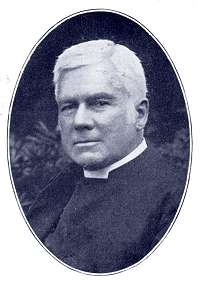Walsham How

William Walsham How;[1](13 December 1823 – 10 August 1897) was an English bishop.
Known as Walsham How, he was the son of a Shrewsbury solicitor, How was educated at Shrewsbury School, Wadham College, Oxford and University College, Durham.[2] He was ordained in 1846, and after a curacy at Kidderminster, began more than thirty years actively engaged in parish work in Shropshire, as curate at the Abbey Church in Shrewsbury in 1848.[3] In 1851 he became Rector of Whittington and was at one point Rural Dean of Oswestry in 1860.
Writings
It was during his period at Whittington he wrote the bulk of his published works and founded the first public library in Oswestry.[3] In 1863–1868 he brought out a Commentary on the Four Gospels and he also wrote a manual for the Holy Communion. Published by the Society for Promoting Christian Knowledge during the 1890s under the title "Holy Communion, Preparation and Companion...together with the Collects, Epistles and Gospels" this book was widely distributed and many copies still survive today. In the movement for infusing new spiritual life into the church services, especially among the poor, How was a great force. He took a stand against what he regarded as immoral literature and Thomas Hardy claimed that he had burned a copy of his novel Jude the Obscure.[4] How was much helped in his earlier work by his wife, Frances A. Douglas (died 1887).
Church work
He refused preferment on several occasions, but his energy and success made him well known, and in 1879 he became a suffragan bishop in London, under the title of bishop of Bedford, his province being the East End. There he became the inspiring influence of a revival of church work. He founded the East London Church Fund, and enlisted a large band of enthusiastic helpers, his popularity among all classes being immense. He was particularly fond of children, and was commonly called the children's bishop.
When he came to East London in 1879 "he found great need of women's help for the poor in the huge parishes of his diocese". He then planned to establish a Deaconess Community and applied to the (West) London Diocesan Deaconess Institution. LDDI sent its Sister Louisa in autumn 1880 and the East London Diocesan Deaconess Institution was founded at Sutton Place, Hackney. Deaconess Sisters worked in various East London parishes and eventually the Institution became the All Saints Deaconess Home at Meynell Crescent (1894/5-1924). A few of the remaining Sisters joined the London Diocesan Deaconess Institution which continued work in the East End for a few years.[5]
Bishopric
In 1888 he was made the first bishop of Wakefield, and in the north of England he continued to do valuable work. His sermons were straightforward, earnest and attractive; and besides publishing several volumes of these, he wrote a good deal of verse, including such well-known hymns as Who is this so weak and helpless, Lord, Thy children guide and keep and For All the Saints. As bishop he consecrated many churches, including the Church of St John the Divine, Calder Grove in 1892.[6][7]
Death

He died while on holiday in Ireland, on 10 August 1897 in Leenane, County Mayo. Although there is a marble memorial to him in Wakefield Cathedral, he was buried in Whittington, Shropshire, where he had been rector for 28 years.[8] There is also a memorial plaque to him inside the London city church of St Helen's, Bishopsgate, bearing the line "Sweet is the calm of Paradise the blest" from his hymn, "For all the saints".
Hymns
How is represented in The Church Hymn Book (1872)[9] with three hymns:
- Jesus! name of wondrous love (n. 794), 1854,
- Soldiers of the cross, arise (n. 1212), 1854,
- We give thee but thine own (n. 1264), 1854;
and in Hymns Ancient and Modern, Revised edition[10] with a several others
- Lord Jesus, when we stand afar (n. 109),
- O Jesu, thou art standing (n. 355),
- O my Saviour, lifted from the earth for me (n. 360),
- It is a thing most wonderful (n. 435),
- For all the Saints, who from their labours rest (n. 527),
- "Thou art the Christ, O Lord" (n. 555),
- To Thee, Our God, we fly (n. 606).
Depictions
How appears as a significant character in Bernard Pomerance's 1979 Broadway play The Elephant Man. In a 1982 television adaptation he was played by William Hutt.
References
- ↑ How, Frederick Douglas (1898). Bishop Walsham How: a memoir. London.
- ↑ Durham University, p. 169.
- 1 2 Dickins, Gordon (1987). An Illustrated Literary Guide to Shropshire. Shrewsbury: Shropshire Libraries. pp. 40–1. ISBN 0-903802-37-6.
- ↑ Slack, Robert C. Nineteenth-Century Fiction 11(4) (March 1957) pp. 261–275.
- ↑ Archives of the (Deaconess) Community of St Andrew (which had developed from the LDDI).
- ↑ Keith Wainwright, Crigglestone Backtrack 4: past reflections of a rural parish (ca. 1996) pp. 54–47, in Wakefield local studies library
- ↑ Leeds Times Saturday 27 May 1893: "Chat in the porch", genesreunited.co.uk; retrieved 21 April 2014.
- ↑ "William Walsham How". Cyberhymnal. Retrieved 2013-11-08.
- ↑ Hatfield, Edwin F. (ed.) (1872). The Church Hymn Book. New York; Chicago.
- ↑ Knight, G. H.; Dykes, J. (ed.) (1950). Hymns Ancient and Modern, Revised ed. Suffolk.
 This article incorporates text from a publication now in the public domain: Chisholm, Hugh, ed. (1911). "article name needed". Encyclopædia Britannica (11th ed.). Cambridge University Press.
This article incorporates text from a publication now in the public domain: Chisholm, Hugh, ed. (1911). "article name needed". Encyclopædia Britannica (11th ed.). Cambridge University Press.
External links
| Wikimedia Commons has media related to William Walsham How. |
| Religious titles | ||
|---|---|---|
| Preceded by diocese created |
Bishop of Wakefield 1889–1897 |
Succeeded by Rodney Eden |